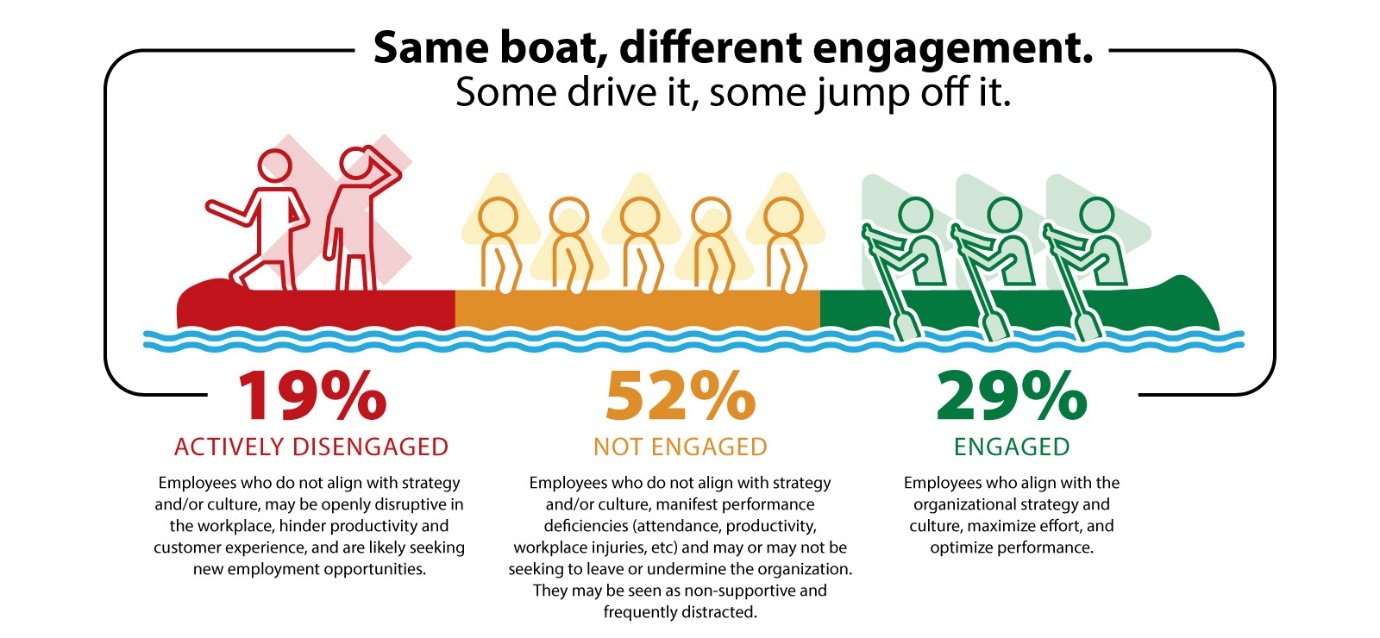
Summary
This article shares how integrated Human Resource (HR) frameworks strategically drive employee engagement, performance, and value for organizations. From decades of experience in HR leadership, Global CHRO of the Year (HRO Magazine, 2015) and as a CEO in addition to consulting in HR & OD, Kawel LauBach identifies six (6) key levers and recommended initiatives to create employee engagement and a heightened employee experience. Ultimately, this article provides actionable pathways for organizations ready to evolve from moderate to high performance.
Today’s Business Imperative
In today’s competitive business environment, employee engagement is no longer a “nice-to-have.” It’s a key driver of organizational performance and success. Engaged employees are more productive, more innovative, and less likely to leave. While 50% to 65% of a workforce is considered a good score, the average across the US places this number at less than 30%.(Gallup)

What’s often overlooked is how the structure and integration of your Human Resources (HR) function can directly and positively impact that engagement.
A fully integrated HR function where strategies, frameworks and departments work together seamlessly is not just a back-office efficiency play. It’s a powerful catalyst for creating a dynamic culture of engagement, trust, and performance.
What Is a Fully Integrated HR Function?
- A fully integrated HR function brings together all HR disciplines such as talent acquisition, onboarding, learning & development, performance management, total rewards, and employee relations under a cohesive strategy supported by unified philosophy, frameworks, and processes.
- This integration breaks down silos, ensures data flows freely, and creates a consistent employee experience aligning the organization with the key mission, vision, values, and goals.
The Engagement Advantage: 6 Focal Points That Drive the Difference
1. Seamless Employee Experience (Forbes)
- From the moment an applicant applies to the day they exit the organization, every interaction with HR matters.
- When HR frameworks and processes are inter-connected, employees experience smoother onboarding, easier access to resources, and more personalized support throughout the lifecycle of their employment. This consistency builds trust and helps employees feel valued from day one.
2. Better Communication and Transparency (Business News Daily)
- Integrated HR tools allow for clearer communication—whether it’s performance feedback, benefits information, or training opportunities.
- When employees don’t have to dig for answers or chase down different departments for help, their frustration decreases and satisfaction increases.
3. Refined Data-Driven Engagement Strategies (Certified Human Resource Management Professional)
- With a unified HR function, organizations can analyze data across the employee lifecycle to identify engagement trends, turnover risks, and development needs.
- This insight enables leaders and HR teams to proactively address issues, tailor initiatives, measure the impact of engagement efforts in real time, and importantly, cross reference to customer sentiment.
- “Employee Engagement: Paving the Way to Customer Loyalty” reports Aberdeen Group’s, 2015 study proving a 233% increase in customer loyalty as a result of higher employee engagement.
4. Succession Planning and Career Pathing (Association for Talent Development)
When learning, performance, and talent data are inter-connected, it becomes much easier to create personalized development plans. Employees can see a clear path for growth, access targeted learning, and receive meaningful feedback—all of which are critical components of engagement.
5. Compassionate and Trusting Leader Support (LinkedIn)
- Integrated HR provides managers with the tools and insights they need to lead more effectively.
- From performance dashboards to engagement pulse surveys, managers can better understand their team’s needs and take timely action, reinforcing a culture of support and accountability.
6. Fostering a Culture of Inclusion and Belonging (Forbes)
When HR ensures inclusive organizational practices and not just stated goals but measurable outcomes, employees who feel seen, heard, and represented are more likely to be engaged and loyal.
Real Business Results
Organizations that invest in integrated HR frameworks and processes often report (Talent Management Institute):
- Higher employee satisfaction scores
- Improved retention rates
- Increased performance, service and productivity of teams and organization
- Greater alignment between employee goals and company strategy
In fact, David Ulrich’s global research study, with 27,904 non-HR leader and 3,964 HR leader respondents across 1,395 organizations, proved integrated frameworks in HR drives 4X organizational performance and value (“Victory Through Organization” by Ulrich, Kryscznski, Ulrich & Brockbank. McGraw-Hill, 2017).
In sum, a well-integrated HR function empowers both employees and leaders to thrive. It moves HR from a transactional support role to a transformational partner in driving culture and engagement.
Case Studies
In multiple, applicable cases by focusing on these six areas my HR teams have achieved marked organizational improvement.
In one specific case, Mohegan Gaming & Entertainment was recognized for the first time in its 30-year history by Forbes Magazine as one of the only two gaming and hospitality companies in its 500 Best Employers in America (2015). This transformation occurred over a period of two years of refined improvement within the HR capacity and it translated to multiple national awards including USA Today 2017 for Best US Casino.
In another example, Osterman Plastics, LLC achieved a market reputation as one of the “Best Plastics Company” to work for in America.
In each of these cases and several others, by concentrating on aforementioned HR areas, organizations have seen drastic improvements in employee engagement leading to better reputation, better recruiting, better retention, and relatedly, better productivity.
Conclusion
Employee engagement isn’t just about perks or opinion surveys. It’s about creating an ethos where people can do their best work. A fully integrated HR function is the foundation for that environment. It aligns people, processes, and technology to deliver a consistent, empowering, and human-centric experience.
In a world where talent is your greatest asset and, in some cases, your most limited resource, integrating HR isn’t just smart, it’s essential.
When your team is ready to assess the current viability of shifting HR’s frameworks for a significant performance boost, let’s schedule a conversation to explore how TheHRC can guide your HR team’s journey to redesign sustainable HR frameworks that will engage your employees and enhance your organization, taking it to its next level of performance and value. Call us toll-free at 855.493.1500.
By Kawel LauBach, MS
Principal
The Human Resource Consortium, LLC
#TheHRC #HR #IntegratedHRSystems #IntegratedHRSolutions #OrganizationDevelopment #HRBestPractices #HRTransformation #HRChangeManagement







